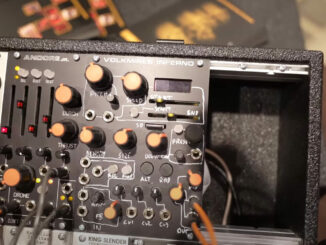Instruo has leveled up its mighty, eye-catching granular module Arbhar to firmware 2.0 with an all-new engine, full-in stereo, and more.
Granular synthesis conquers Eurorack. This has been the case for several years, but thanks to increasingly powerful hardware platforms, these are becoming more and more deep. With the Arbhar, Instruo has a granular module in its portfolio that is not only fascinating regarding sound. Its front panel is so beautiful and eye-catching that once it’s in the rack, it’s hard to take your eyes off it.
This week, Qu-Bit Electronix unveiled Mojave, a modern, hands-on granular processor for Eurorack. At the same time, Instruo released firmware 2.0 for the Arbhar, which ultimately turned the module on its head. This makes the week a perfect granular week.
With the introduction of firmware version 2 (2023) comes a complete rewrite of the entire codebase to implement both technical and conceptual improvements that will enhance the entire user experience of arbhar. We have ensured that the overall feel of the module has been preserved as much as possible. Advances in efficiency and expanded features will allow arbhar to explore many more sonic and musical spaces.
Instruo Arbhar 2.0
The new firmware 2.0 turns the Arbhar to the top regarding features. Instruo has rewritten the entire codebase of the Lexer Method by adding many new features and improvements.
Arbhar 2.0 features two granular engines that work in mono and stereo input configurations. It has a total of six 10-second audio buffers, and you can create up to 88 sounding polyphonic grains between the two engines. You can scan through the grains, use a follow mode, or turn the module into a unique wavetable oscillator.
Other creative features are built-in pitch randomization and grain detection probability. This allows you to put the grains on a rollercoaster. The user can feed the processor with sounds via the stereo input or dump samples onto the 4GB USB flash drive, which then can be mangled in real-time.
The latter also benefits in firmware 2.0 from improved sample management. Alternatively, you can automatically capture sounds using the built-in condenser microphone, pre-amp, and limiter.
Also, a new feature is the ability to save, load, and clone between layers and save entire configurations with up to 42 scenes. Like the predecessor, it also tracks the pitch at 1 volt per octave.
Summary
- Up to 88 sounding polyphonic grains between two granular engines
- Mono and stereo input configurations
- Six 10 second individual audio buffers
- 1 volt per octave pitch tracking
- On-board random pitch deviation and grain direction probability
- Scan Mode, Follow Mode, and Wavetable Mode
- Stereo pan, feedback delay, and reverb configurations
- Built-in condenser microphone
- Analogue input preamplifier and limiter
- USB import and export functionality
- Audio analysis with onset detection for automatic audio capturing
- User-definable configuration file for complete instrument customization
- Includes 2 HP passive CV Expansion module, 2 HP Passive USB Expansion module, and 4GB USB flash drive
To get a detailed overview of what’s new, I invite you to watch Jason Lim’s new video about Arbhar 2.0.
First Impression
Arbhar was already a beast in the first firmware versions. With the Arbhar 2.0, Instruo has given the beast even more teeth and power. Arbhar has evolved and is now waiting for long granular journeys.
Instruo Arbhar 2.0 firmware is available now as a free download for existing users. The new Arbhar 2.0 will be shipping soon for $675/678,30€
More information here: Instruo Modular
Available at my partners





Be the first to comment